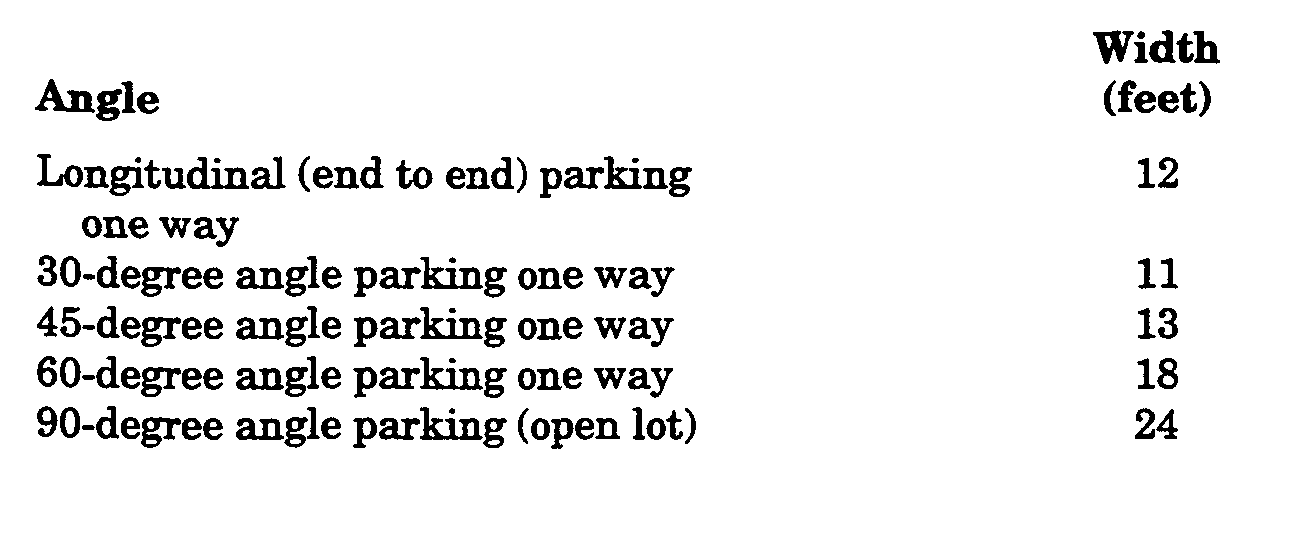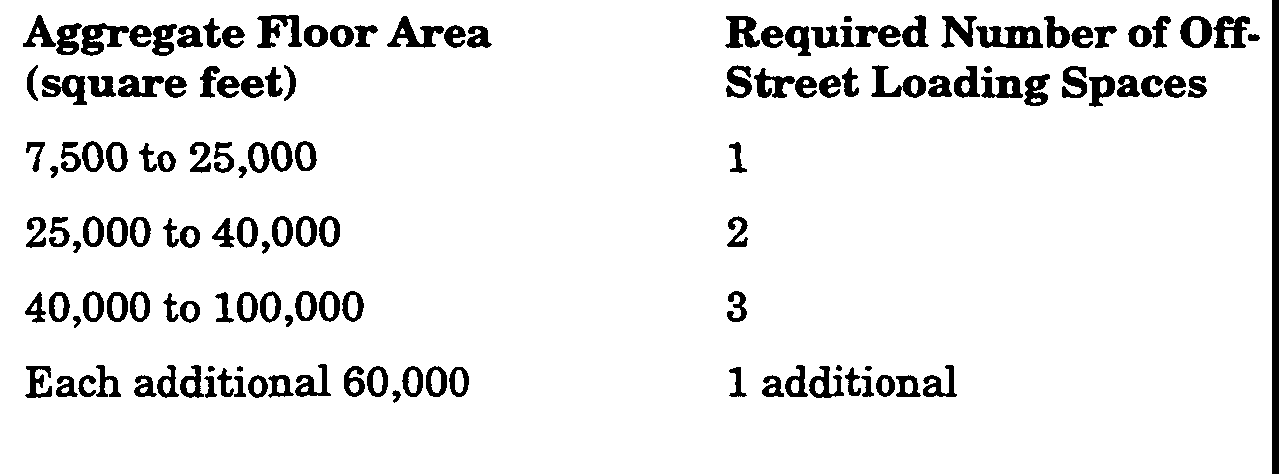No new building shall hereafter be erected and no existing building shall be altered to increase its floor area or to increase use of occupancy unless and until off-street parking facilities as set forth below shall be provided for the storage or parking of passenger motor vehicles for the use of occupants, employees or patrons of buildings erected or for the portion enlarged or altered.�
In this chapter, an off-street parking space available for the parking of a motor vehicle is held to be a minimum of nine feet wide and 18 feet long, exclusive of passageways, driveways, aisles and roadways appurtenant thereto and giving access thereto. Entrance and exit roadway shall not be computed as parking space except for single-family residences. No area in existing right-of- way areas in public roads shall be used to satisfy the parking space requirements.�
All commercial and industrial buildings shall have provided an adequate area for loading and unloading, which area shall be exclusive of that area herein required for off-street parking.�
Required loading spaces shall have a minimum dear height of 15 feet.�
If a use is not listed in the Schedule of Parking Requirements, then the number of required off- street parking spaces becomes the number of spaces required for the use which most nearly approximates the proposed use.�
Off-street parking area for more than five automobiles shall be paved and lighted according to the specifications established for this purpose by the borough.�
All off-street parking spaces within any parking area shall be clearly marked to show the parking arrangement within said parking area. Line markings shall be maintained by the owner to keep parking spaces visually delineated.�
All lighting for off-street parking areas shall be so arranged and shielded as to reflect the light downward and prevent any light from shining directly on adjoining streets and residential zones and buildings.�
No new off-street parking or loading spaces shall be located in any required front yard. Expansion of parking spaces or parking areas in the required front yard is prohibited. No new off-street parking or loading spaces shall be located in the public right-of-way.�
The requirements for parking and loading areas shall include adequate means of ingress and egress.�
No access driveway to a parking or loading area in a business or industrial district shall be located within a residential district. No off-street parking shall be permitted in any zone where the use which it serves is prohibited.�
Access to off-street parking areas shall be limited to several well-defined locations. Each of said curb cuts shall not exceed 12 feet in width in a residential district. In a business or industrial district, curb cuts shall not exceed 30 feet for any permitted use. In no case shall there be permitted any unrestricted access along the length of the street or streets upon which the parking area abuts. All driveway aprons and parking access points shall be paved.�
In a residential district, the following motor vehicles and boats shall not be parked or left standing in any front or side yard area or on a driveway:�
�
A. Unregistered motor vehicles of any type or design.�
B. Buses.�
C. Trucks, tractors and trailers, meaning motor vehicles designed and used primarily for drawing other vehicles and not so constructed as to carry a load other than part of the weight of the vehicles and load to be drawn.�
D. Trucks, trailers, vans and other vehicles described in §197-13, Parking or storing of commercial vehicles prohibited.�
E. Boats and boat trailers of any type or design.�
Off-street parking spaces shall be provided in accordance with the Schedule of Parking Requirements.�
The required parking for multiple uses may be provided in one contiguous parking area if the total number of spaces is not less than the sum of the required spaces for the individual uses. The reviewing board may allow a specific number of parking spaces not to exceed 30% of the total parking spaces located in such parking area, to be designated for joint use if it finds that each use will have sufficient parking because the uses operate at different times and the peak periods of use do not coincide. Where the individual uses are under different ownership or control, the continued availability of such spaces shall be guaranteed by a suitable legal instrument which provides for each proposed use, the number of parking spaces to be available and the times when available.�
The minimum width of access aisles and traffic flow. in the aisles shall be related to the angle of the parking spaces as follows: �

At least one off-street loading space shall be provided for every business and industrial use. Those establishments which have an aggregate floor area of 7,500 square feet or more devoted to any such use shall be provided with off-street loading spaces at the rear of the building as follows:�

All driveway, parking and loading areas shall be so constructed to provide sufficient drainage to prevent an accumulation of water upon the surface of the lot or from being directed onto the surface of adjoining lots or public rights-of-way.�
Parking spaces shall be provided according to the following schedule:�